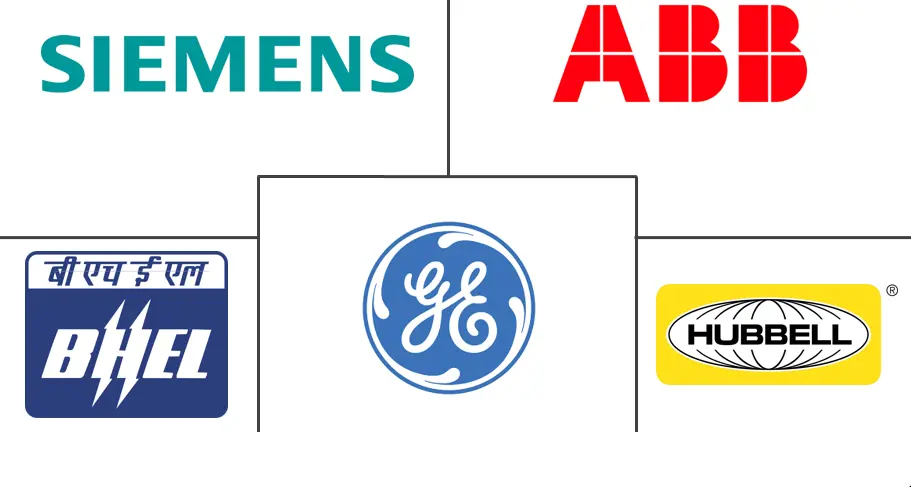Market Size of Electric Insulator Industry

| Study Period | 2020 - 2029 |
| Base Year For Estimation | 2023 |
| CAGR | 7.81 % |
| Fastest Growing Market | Asia-Pacific |
| Largest Market | Asia Pacific |
| Market Concentration | High |
Major Players
*Disclaimer: Major Players sorted in no particular order |
Electric Insulator Market Analysis
The electric insulators market is expected to record a CAGR of approximately 7.81% during the forecast period of 2022-2027. The outbreak of COVID-19 in Q1 of 2020 had a negative impact on the electric insulators market. Lockdown restrictions imposed by various governments globally affected the end-user demand, as electric construction remained halted during Q1 of 2020. Additionally, disruptions in the supply chain and global shipping have also affected the market. With the rapid integration of renewables and distributed technologies onto the grid, utilities are increasingly upgrading their existing infrastructure. The development of renewable-based power generation is expected to result in the expansion of T&D infrastructure, resulting in an increase in demand for electric insulators over the coming years. However, the increasing adoption of underground and overhead cables in the T&D infrastructure is expected to hinder the growth of demand for electric insulators in the long run.
As of 2020, a significant share of electrical insulators was made of ceramic/porcelain material. These kinds of insulators are primarily used when the requirement of physical strength is high.
Africa has an aspirational goal to achieve universal electricity access by 2025 with a strong focus on encouraging clean and renewable energy solutions. To achieve the goal, 160 GW of new generation capacity, 130 million new on-grid connections, 75 million new off-grid connections, and providing 150 million households with access to clean cooking solutions are required. Therefore, the combined result of universal access to electricity and the Power Africa program is expected to create huge potential for T&D infrastructure development and create opportunities for electric insulator manufacturers.
Asia-Pacific was estimated to dominate the global market in 2020, with a majority of the demand coming from China and India.
Electric Insulator Industry Segmentation
The electric insulator market report includes:
| Dielectric Material Type | |
| Ceramic/Porcelain | |
| Glass | |
| Composite/Polymer |
| End User | |
| Residential | |
| Commercial | |
| Industrial Sector/Utilities |
| Geography | |||||||
| |||||||
| |||||||
| |||||||
| |||||||
|
Electric Insulator Market Size Summary
The electric insulator market is poised for significant growth, driven by the increasing integration of renewable energy sources and the expansion of transmission and distribution (T&D) infrastructure. The market experienced a setback due to the COVID-19 pandemic, which disrupted supply chains and halted construction activities. However, the ongoing shift towards renewable energy and the need to upgrade existing grid infrastructure are expected to boost demand for electric insulators. Despite the potential hindrance posed by the adoption of underground and overhead cables, the market is anticipated to benefit from the growing energy consumption and the expansion of T&D networks, particularly in regions like Asia-Pacific, where rapid industrialization and urbanization are occurring.
Ceramic and porcelain insulators dominate the market, especially in high-voltage applications, due to their physical strength and stability across temperature variations. The demand for these insulators is expected to rise as countries like China and India expand their power generation capacities and T&D infrastructure to accommodate increasing electricity demand and renewable energy penetration. The global market remains fragmented, with key players such as ABB Ltd, Siemens AG, and General Electric Company actively participating. Innovations in insulation materials and eco-friendly alternatives are also shaping the market landscape, promising a robust outlook for electric insulators in the coming years.
Electric Insulator Market Size - Table of Contents
-
1. MARKET OVERVIEW
-
1.1 Introduction
-
1.2 Market Size and Demand Forecast, in USD billion, till 2027
-
1.3 Recent Trends and Developments
-
1.4 Government Policies and Regulations
-
1.5 Market Dynamics
-
1.5.1 Drivers
-
1.5.2 Restraints
-
-
1.6 Supply Chain Analysis
-
1.7 Porter's Five Forces Analysis
-
1.7.1 Bargaining Power of Suppliers
-
1.7.2 Bargaining Power of Consumers
-
1.7.3 Threat of New Entrants
-
1.7.4 Threat of Substitute Products and Services
-
1.7.5 Intensity of Competitive Rivalry
-
-
-
2. MARKET SEGMENTATION
-
2.1 Dielectric Material Type
-
2.1.1 Ceramic/Porcelain
-
2.1.2 Glass
-
2.1.3 Composite/Polymer
-
-
2.2 End User
-
2.2.1 Residential
-
2.2.2 Commercial
-
2.2.3 Industrial Sector/Utilities
-
-
2.3 Geography
-
2.3.1 North America
-
2.3.1.1 US
-
2.3.1.2 Canada
-
2.3.1.3 Rest of North America
-
-
2.3.2 Europe
-
2.3.2.1 Germany
-
2.3.2.2 UK
-
2.3.2.3 France
-
2.3.2.4 Rest of Europe
-
-
2.3.3 South America
-
2.3.3.1 Brazil
-
2.3.3.2 Argentina
-
2.3.3.3 Rest of South America
-
-
2.3.4 Asia-Pacific
-
2.3.4.1 China
-
2.3.4.2 India
-
2.3.4.3 Japan
-
2.3.4.4 South Korea
-
2.3.4.5 Rest of Asia-Pacific
-
-
2.3.5 Middle-East and Africa
-
2.3.5.1 Saudi Arabia
-
2.3.5.2 South Africa
-
2.3.5.3 Rest of Middle-East and Africa
-
-
-
Electric Insulator Market Size FAQs
What is the current Electric Insulator Market size?
The Electric Insulator Market is projected to register a CAGR of greater than 7.81% during the forecast period (2024-2029)
Who are the key players in Electric Insulator Market?
ABB Ltd, Siemens AG, General Electric Company, Hubbell Inc. and Bharat Heavy Electricals Limited are the major companies operating in the Electric Insulator Market.

